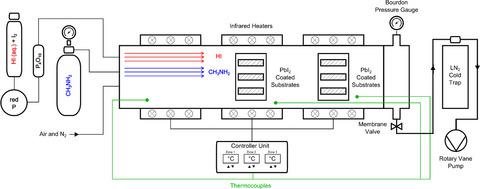当前位置:
X-MOL 学术
›
Energy Sci. Eng.
›
论文详情
Our official English website, www.x-mol.net, welcomes your feedback! (Note: you will need to create a separate account there.)
Preparation of methylammonium lead iodide (CH3NH3PbI3) thin film perovskite solar cells by chemical vapor deposition using methylamine gas (CH3NH2) and hydrogen iodide gas
Energy Science & Engineering ( IF 3.8 ) Pub Date : 2020-05-22 , DOI: 10.1002/ese3.734 Claudiu Mortan 1 , Tim Hellmann 1 , Moritz Buchhorn 1 , Marco d'Eril Melzi 1 , Oliver Clemens 2 , Thomas Mayer 1 , Wolfram Jaegermann 1
Energy Science & Engineering ( IF 3.8 ) Pub Date : 2020-05-22 , DOI: 10.1002/ese3.734 Claudiu Mortan 1 , Tim Hellmann 1 , Moritz Buchhorn 1 , Marco d'Eril Melzi 1 , Oliver Clemens 2 , Thomas Mayer 1 , Wolfram Jaegermann 1
Affiliation

|
An upscalable chemical vapor deposition setup has been built‐up and employed in producing methylammonium lead iodide (MAPI) thin film perovskite solar cells, leading to a maximum efficiency of 12.9%. The method makes use of methylamine gas and hydrogen iodide gas to transform a predeposited layer of lead(II)iodide (PbI2) into MAPI. Although the reaction mechanism includes the intermediate phases lead oxide (PbO) and lead hydroxide (Pb(OH)2), indicated at least on the surface of the samples by XPS, neither species could be observed in XRD measurements of the stepwise reaction, which show a mixture of highly oriented cubic and tetragonal MAPI perovskite lattice systems.
中文翻译:

利用甲胺气体(CH3NH2)和碘化氢气体的化学气相沉积法制备甲基碘化碘化铅(CH3NH3PbI3)薄膜钙钛矿太阳能电池
建立了可升级的化学气相沉积装置,并用于生产甲基铵碘化铅(MAPI)薄膜钙钛矿太阳能电池,最高效率为12.9%。该方法利用甲胺气体和碘化氢气体将碘化铅(II)(PbI 2)的预沉积层转化为MAPI。尽管反应机理包括中间相氧化铅(PbO)和氢氧化铅(Pb(OH)2),至少在XPS样品表面上显示,但在逐步反应的XRD测量中均未观察到任何物质。显示出高取向立方和四方MAPI钙钛矿晶格体系的混合物。
更新日期:2020-05-22
中文翻译:

利用甲胺气体(CH3NH2)和碘化氢气体的化学气相沉积法制备甲基碘化碘化铅(CH3NH3PbI3)薄膜钙钛矿太阳能电池
建立了可升级的化学气相沉积装置,并用于生产甲基铵碘化铅(MAPI)薄膜钙钛矿太阳能电池,最高效率为12.9%。该方法利用甲胺气体和碘化氢气体将碘化铅(II)(PbI 2)的预沉积层转化为MAPI。尽管反应机理包括中间相氧化铅(PbO)和氢氧化铅(Pb(OH)2),至少在XPS样品表面上显示,但在逐步反应的XRD测量中均未观察到任何物质。显示出高取向立方和四方MAPI钙钛矿晶格体系的混合物。



























 京公网安备 11010802027423号
京公网安备 11010802027423号